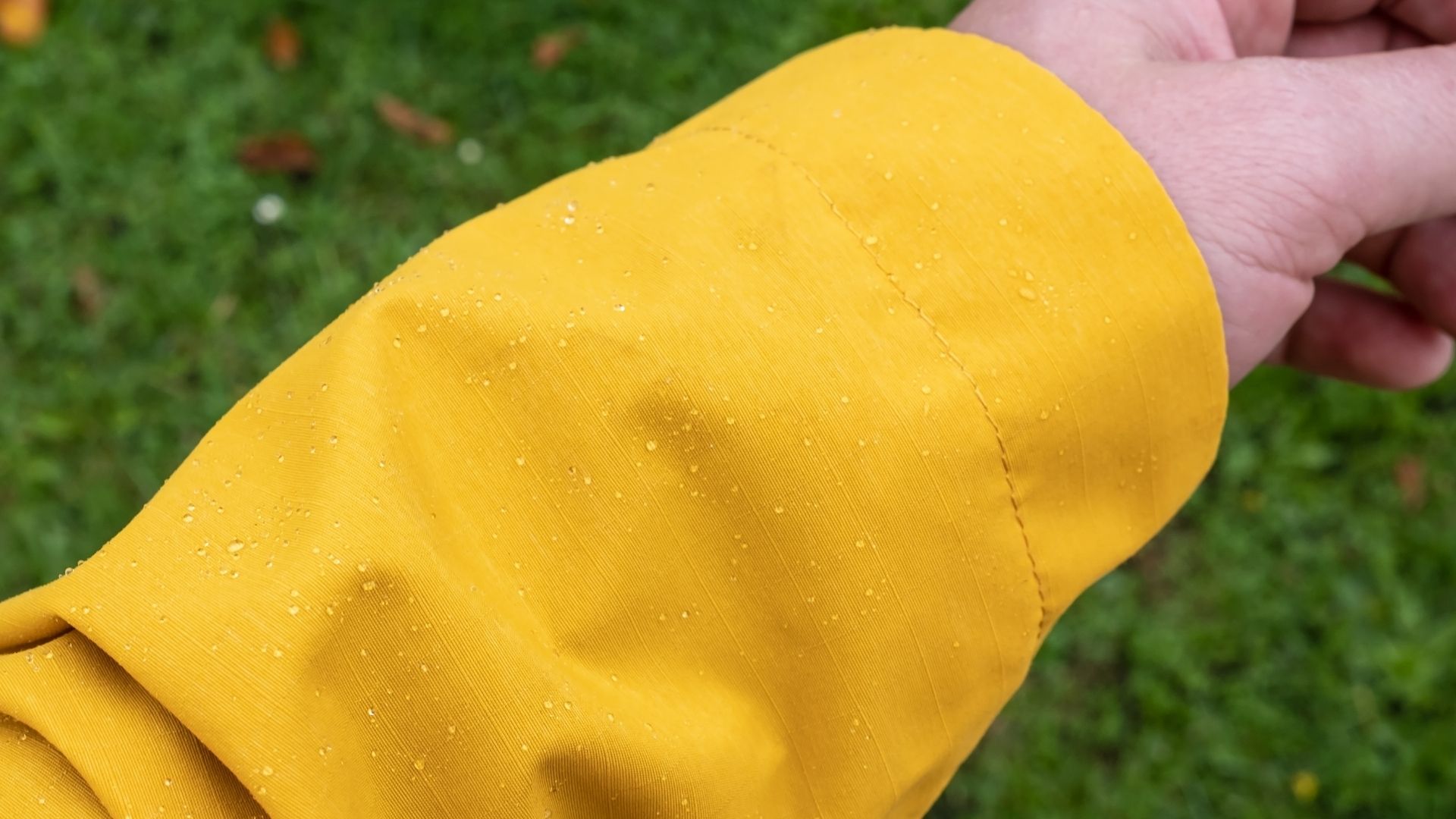Bluesign has announced that it will no longer approve any materials made with PFCs. The tide is turning toward sustainable and safe PFC-free DWR in textile production. So are we!
Did you know that the concept of applying a coating to improve the water-repellency of materials has been around for centuries? Historically, mariners found that applying linseed oil to their ship sails significantly boosted their water-repelling capabilities. Today, Durable Water Repellent, or DWR for short is being used widely in the production of outdoor wear, bags, tents, gloves, footwear… Basically in everything that can benefit from improved water repellency.

What is DWR?
Durable Water Repellent (DWR) works by applying a polymer that reduces the surface tension of the fabric. When the surface tension of the fabric is lower than that of a liquid, the liquid will bead up and roll off, rather than soak into the material. For example, water molecules have a surface tension of about 70 millinewtons (mN) per meter. This is higher than that of C6 (10 mN) and C0 (20 mN) DWR coatings, making both types effective in enhancing the water-repellency of fabric. However, the surface tension of oil is much lower, approximately 20 mN, which makes PFC-free (C0) DWR less effective at repelling oil-based substances, potentially leaving stains on the garments.
However, it's important to note that while DWR is water-repellent, it is not inherently waterproof. The effectiveness of DWR is a combination of the coating, the underlying fabric, and, in some cases, a waterproof membrane.

Industry Shift to Environmentally-Friendly DWR
For decades, DWR coatings have been made using perfluorocarbons (PFCs), known as ‘forever chemicals’ for their persistence in air, water, food, and even our bodies, raising serious health concerns. Studies show that 98 percent of the US population has fluorocarbons in their system!
In response to these concerns, the industry began shifting its practices. In 2015, the U.S. Environmental Protection Agency (EPA) enhanced its regulation of PFCs, prompting a move away from long-chain fluorocarbon-based treatments (C8 DWR) to the less harmful short-chain C6 alternatives. But what a bummer! Not long after, new studies discovered C6 to be just as damaging. These new findings accelerated research and development efforts to produce and implement environmentally friendly, PFC-free (C0) DWR.
Legislation in many countries is finally catching up. The ban on fluorochemicals is supposed to become effective in California by January 1, 2025, followed by the EU later in 2025 or 2026. The globally renowned recycled standard, Bluesign, has announced that it will no longer approve any materials made with PFCs. The tide is clearly turning towards a more sustainable and health-conscious future in textile production.

C8 vs. C6 vs. C0 DWR
The transition from C8 to C6 DWR was relatively seamless, yet many companies continue to use C6 DWR, hesitating to fully switch to PFC-free options. This is because of the functional advantages of C6, which, to date, cannot be entirely matched by PFC-free alternatives. Let's delve into a more detailed comparison.
A primary drawback of C0 compared to its C6 and C8 counterparts is its inability to repel oil. While water droplets will bead up and roll off the fabric surface, oily substances will leave stains on the garments. Another significant issue is the potential for C0 DWR treatments to change the original color of the fabric during the manufacturing process due to their different chemical composition which can react with fabric dyes. Additionally, especially on darker fabrics, C0 DWR can leave behind 'chalk marks'—white trace lines that become visible after the fabric has been handled.
But C0 DWR isn’t without its advantages (in addition to protecting humanity and the planet). Fabrics treated with PFC-free Durable Water Repellent show improved tear strength compared to those treated with C6 and C8.
Past discussions on water-repellent applications highlighted issues with applying C6 and C0 to natural fibers like cotton. However, continuous and extensive research in the textile industry has successfully overcome these challenges. Now, DWR treatments can be applied effectively to natural fabrics, in addition to polyester and nylon.
%20(1).jpg)
![]()
Is DWR Permanent?
As protective as they are, Durable Water Repellent (DWR) treatments are not permanent; they tend to wear off over time due to abrasion, exposure to detergents, dirt, and oils, and the breakdown of the DWR chemicals themselves. To maintain the effectiveness of DWR treatments on garments, it is recommended to clean them regularly with gentle, DWR-safe detergents and to avoid fabric softeners, which can damage water repellency. After washing, reactivating the DWR by tumble drying the garment on a low or medium heat setting, can help. If water no longer beads on the surface, reapplying a DWR treatment may be necessary. There are different spray-on or wash-in DWR products available that can be used to restore water repellency. Following these steps will help ensure that your garments retain their water-resistant properties for as long as possible.
Where We Are
At Flyingtex C8 DWR is a relic of the past. Recognizing the detrimental effects of perfluorocarbons, we completely phased out C8 and embarked on a journey to replace C6 with PFC-free DWR. Currently, our production comprises roughly 80% of fabrics with PFC-free DWR and 20% with C6. However, our dedicated research and development team is constantly working to address the technical challenges associated with C0 DWR to transition fully to it.
Sorry for not offering grand promises of a complete C6 phase-out by a specific date—a common practice among companies. Instead, we prefer to approach this realistically, acknowledging the complexities and obstacles of the transition. Rest assured, we are committed to this path and are making steady progress toward our goal.




%20(1).jpg)



